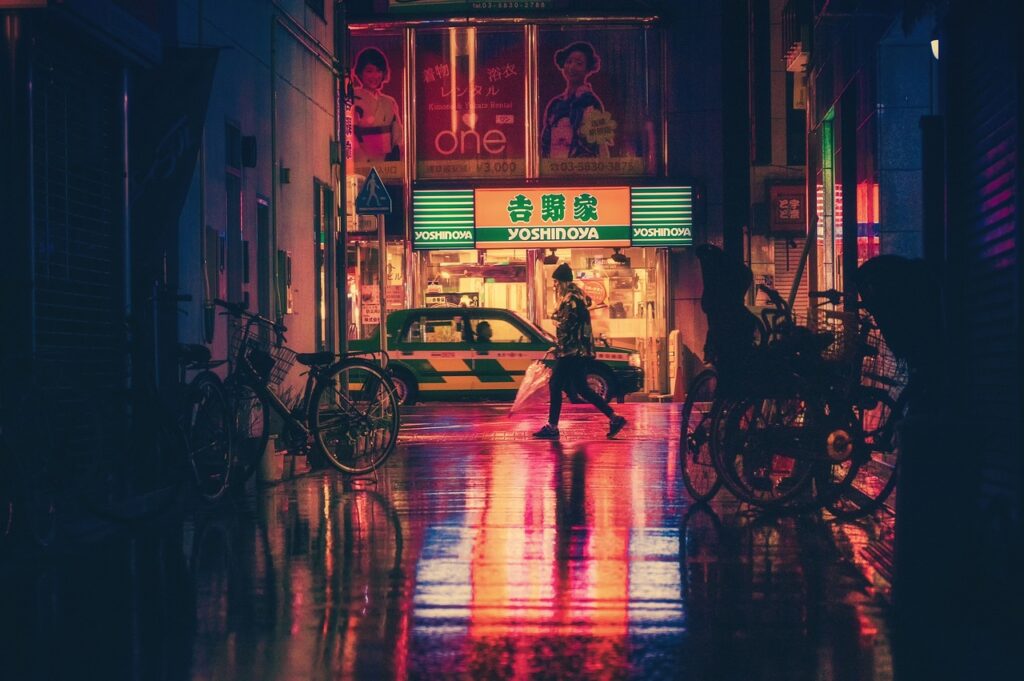November 28, 2022
Review of Popular Hits of the Showa Era by Ryū Murakami
I want to start this review of Popular Hits of the Showa Era, by Ryū Murakami, by saying that it surprised me with its audacity. The fact that I was surprised is… surprising itself, because I’ve read plenty of Ryū Murakami’s novels – parenthetically, no relation to Haruki Murakami – and they’re all as audacious.
And yet, there was something about Popular Hits of the Showa Era that made it profoundly daring and disturbing in abstract, symbolic ways. As you can perhaps tell by this comment, I really liked the book.
But I must warn you: It’s a book that is very difficult to like; the average reader will probably be disgusted by it. Reading Popular Hits of the Showa Era is an experience similar to reading American Psycho, by Bret Easton Ellis: a misunderstood masterpiece that hides a riot of meaning under the deceptive surface.
All this makes this review of Popular Hits of the Showa Era all the more important. There are lessons to learn about writing, reading, and art in general.

Review of Popular Hits of the Showa Era: Genre, Plot, Narrative
Let’s admit it right away: Popular Hits of the Showa Era contains explicit, disturbing violence. I mean, if you look at the plot premise, you can see why: A group of young men at the margins of society pass their time meaninglessly drinking and singing karaoke, until one of them, for no particular reason, kills a random woman in her late thirties – an oba-san, or “auntie”. The friends of the murdered woman, all women in their mid-to-late thirties, take matters into their own hands.
It’s completely pointless to speak of genre; it’s a Ryū Murakami novel. As novels like In the Miso Soup, Audition, or Coin Locker Babies have portrayed, Murakami’s stories are replete with what another review has aptly termed “entertaining psychopaths”, and thus often veer in the direction of crime fiction (but never actually get there; most of the crime fiction tropes are absent). The line between entertainment and actual literary importance is somewhat hard to discern in some of his novels, but this is certainly not the case in Popular Hits of the Showa Era.
The Two Realities
Popular Hits of the Showa Era operates on (at least) two levels simultaneously. I have talked about the importance of multiple endings, as well as about the only social responsibility of an author (if even that) being to produce works that are interpretatively fluid, symbolic, and open-ended.
On the one hand, Murakami’s novel offers gory, disturbing descriptions of two groups of people descending into increasingly more violent acts, murdering each other as if it were no different from visiting the local pachinko parlor. Even beyond violence and suffering, the novel contains plenty of descriptions of bodily functions – from losing bladder control to becoming sexually aroused – whose purpose seems to be to deliberately (and unashamedly) make readers uncomfortable.
However, it’s all entirely justified.
Indeed, as one of the themes of the novel is voyeurism – the act of seeing unseen, often with nefarious purposes in mind – these descriptions become part of this framework. The theme is built into the fabric of the novel, on a meta- kind of way, with the author implicitly acknowledging that he’s doing the very same thing he “accuses” his characters of, at the same time – and here lies the brilliance of Murakami – turning his readers into accomplices!
Which takes us to the other reality of the novel, the symbolic one.
Absurdity as a Literary Device
As I’ve mentioned in much more detail in my post on symbolism, narratives usually signal the presence of alternative interpretations. Whenever something feels “off”, whether linguistically or narratively, something is hidden there (unless of course the author has simply produced an incoherent narrative).
In the case of Popular Hits of the Showa Era, this signal is absurdity.
To put it simply, the novel becomes increasingly more absurd, even within its own universe. This means that, at first, the reader encounters characters and scenes, dialogues and descriptions that are, shall we say, a bit “out of the ordinary”, yet still somewhat acceptable: a group of men fumbling with snacks, laughing hysterically, or becoming excited about a woman undressing in another apartment; a group of women all called Midori; a junior college girl of preposterous ugliness (or so we are told) who sees and can talk with ghosts.
The Breaking Down of Realism
Yet as the novel progresses, whatever frail claim to realism begins to break down (deliberately, of course) as the story reaches Beckettian levels of absurdity.
Just imagine the group of oba-sans, the “aunties”, meeting with a man of the Japanese Self-Defence Forces (mightily peculiar and absurd in his own right) to illegally buy anti-tank weaponry. Imagine the women exchanging the skirts and high heels for black balaclavas and army boots, launching a nighttime attack against their foes. Not to mention, imagine the ending, where… I won’t go there, but it truly reaches untold proportions of absurdity – that, crucially, is perfectly consistent with the narrative that preceded it.
The ending of Popular Hits of the Showa Era is what I call a surprising-but-inevitable ending: It is surprising (for, as I said, it reaches an untold degree of absurdity), yet, considering the logic of the novel and the overall narrative before it, you really can’t imagine any other way to end the story that would do it justice.
But what is there hiding under the surface? What is the other reality, beneath all the violence and the gory descriptions? To address that part, we need to take a look at the characters of the novel.

Review of Popular Hits of the Showa Era: Characters
Though the novel features plenty of individual characters (at the beginning there are six young men and six “aunties”), there really are only two narrative characters: the group of the men and the group of the women. There is one protagonist and one antagonist. Which of the two groups is which remains for the reader to decideIf you’re a perceptive reader, you might detect that the very fact there is a decision to be made hides yet another level of abstractness and symbolism. Choosing either of the two groups as a protagonist, a perspective to follow the story from, implicitly places you in a peculiar position considering the two groups are water-tightly defined in terms of identity. I will leave the specifics up to you to figure out, but here’s a hint:
Recall what I said about Murakami turning his readers into accomplices, and how all this helps you reflect on the in-betweenness required to break free of polarization of thought and binary dilemmas. – there are elements that could argue the narrative shifts the weight just a bit, but I don’t want to go there.
Inside each group, there is little variation. Of course there are personal stories and traits, and individual actions, but overall the narrative isn’t preoccupied with that. It certainly doesn’t waste any time developing any one character in length, and that’s clearly the right decision.
Besides, all characters in the novel, the young men and the oba-sans, share a crucial commonality: They completely lack things like emotional IQ, deep self-reflection, and most of all, the ability to function in a confusing society. Most are employed, but that’s the limit of their interaction with other human beings – and the novel subtly but powerfully makes sure to wonder how they manage at work.
Appearance Is Everything
Appearance becomes everything; people are criticized for their looks and little else. Besides the obvious examples, such as the junior college girl that – if we believed the other characters – is so ugly that makes them lose their bladder control, there are plenty of other subtle, high-quality hints that pervade the narrative and clearly define its conceptual framework. For instance, one of the women is criticized by her friend for not having put as much lipstick as usual, and such a thing, the friend claims, might draw attention and reveal their murderous plans.
Equally telling is a scene with clear gender-identity undertones, only the dynamics are completely defamiliarized. The group of the men, in one of their nighttime karaoke excursions, decide to dress up for the role, wearing leather miniskirts, fishnet stockings, high heels, and putting on makeup. When the women – dressed to kill, only… literally – see them, their reaction is that of disgust. One of them, in a manner blood-chillingly reminiscent of the worst right-wing fanatics, thinks: “Is this what Japan struggled through its whole postwar history to achieve?”
What Popular Hits of the Showa Era does is to show how in the context of complete social alienation – and the reader can reflect on the paths that led to such a condition, finding connections with capitalism, politics, and cultural dynamics – it’s much easier to hurt people than to care for them.
This grim, pessimistic, absurd reality is interrupted on very few occasions, but it’s precisely the scarcity of humanity in the novel that makes these isolated incidents worthwhile.
The Scarcity of Humanity
On one occasion, a drunken man approaches one of the women in the night, and asks for directions. She tries to help – not out of empathy, but rather to get rid of him quickly – and politely explains where he needs to go. The man goes on to emotionally narrate how he’s living alone because his girlfriend left him. He finishes with “Er, forgive me. I already knew where Block Two was, but I asked you anyway because I wanted to have, you know, a normal conversation. Just a regular conversation […] You very kindly tried to help, and I really appreciate that, I really really appreciate it”.
On another occasion, a woman recalls a childhood memory and her father trying to help her light some fireworks. One of them severely burns his hand, and the woman remembers “he didn’t want me to worry, so even though he was biting his lip to keep from screaming he tried to smile […] telling me it didn’t hurt, didn’t bother him at all […] It made me feel like, you know, like he really cared about me”.
Tellingly, on both occasions, the characters fail to take advantage of the experience and comprehend what hides in plain sight – fact which of course assigns tragic elements to the narrative.
Review of Popular Hits of the Showa Era: General Impression
Though linguistically speaking Popular Hits of the Showa Era is an easy book to read – short, fast-paced, with easily flowing chapters – it’s also a difficult book to like; there’s a lot of blind violence and harrowing suffering, both physical and mental. Moreover, the novel’s characters are generally very unlikable – whether because of their actions or thoughts, or the lack thereof. Overall, there is preciously little genuine empathy in the story.
Yet the overall affective impact of Popular Hits of the Showa Era is immense. There is deep artistic value in the novel, perhaps even beyond the author’s conscious intent. This is often the case with works operating under the wider umbrella of the Gothic tradition. Contemporary critics of Bram Stoker’s Dracula mentioned a feeling of transgression reading the book, saying they weren’t sure what was the source, yet adding that they weren’t sure Stoker was sure, either.
Popular Hits of the Showa Era is absurd; absurdly violent, absurdly open to interpretations, yet also absurdly poignant when it comes to criticizing a society facilitating (if not encouraging) complete alienation and isolation. There are many discussions the novel can inspire, pertinent to gender and identity, love and loyalty, and of course relationships both romantic and parentalIntriguingly, similar themes of abandonment and despair echo across these relationships. A character’s pathetic request to his cheating wife – "It’s okay if you want to keep seeing the guy, just please don’t leave me!" – is matched in humiliation by the response of another character’s parents to their son’s urgent request for financial help due to a medical emergency. Instead of money, they send tangerines and vacuum-packed eels, with a note reading:"We’re having a hard time ourselves—hope this helps you pull through!".
Considering the time the book was written (1994), we could even say it foretold the crisis of the social media generation – with the fetishization of appearance, the categorization of identity, and the synecdochization of self. I’ll refrain from elaborating on this but, instead, I could end this review with a relevant excerpt from the book:
But now, face-to-face with this junior college girl who seemed to be made of one hundred percent disease particles, they were united in a lack of competitiveness and an utter inability to laugh. This was a woman they would not be capable of facing unless they worked together, unless they (at least figuratively) held hands, clung to each other, and squealed, I’m afwaid!
“May I ask your name?” said Nobue. It was the first time since his early years in grade school that he’d been able to address a female in a normal and courteous way. This surprised him, and it surprised Ishihara too.
I don't show you ads, newsletter pop-ups, or buttons for disgusting social media; everything is offered for free. Wanna help support a human internet?
(If you'd like to see what exactly you're supporting, read my creative manifesto).
